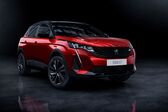Car Specs Peugeot 3008 3008 II (Phase II, 2020) 1.6 (300 Hp) Hybrid4 Automatic
Peugeot 3008 II (Phase II, 2020) 1.6 (300 Hp) Hybrid4 Automatic Specs
Peugeot 3008 II (Phase II, 2020) 1.6 (300 Hp) Hybrid4 Automatic has been in production since 2020 - present. Cars comes in SUV body types and can be suited with petrol / electricity engine types with a volume of 1.6L liters, engines produces a power of 200 Hp. The overall dimensions of the car are 4447x1841x1624 mm, and the weight is from 1840 kg.
General data Generation 3008 II (Phase II, 2020) Modification 1.6 (300 Hp) Hybrid4 Automatic Start of production September, 2020 year Powertrain Architecture PHEV (Plug-in Hybrid Electric Vehicle) Body type SUV Seats 5 Doors 5 Fuel Type petrol / electricity Fuel consumption (economy), emissions Emission standard Euro 6d-ISC Performance specs Acceleration 0 - 100 km/h (0 - 62 mph) 6.1 sec Maximum speed 240 km/h Weight-to-power ratio 6.1 kg/Hp, 163 Hp/tonne Max speed (electric) 135 km/h Electric cars and hybrids specs Battery capacity 13.2 kWh Engine technical data Power 300 Hp System torque 520 Nm Power 200 Hp @ 6000 rpm. Power per litre 125.2 Hp/l Torque 300 Nm @ 3000 rpm. Engine location Front, Transverse Engine displacement 1598 cm3 Number of cylinders 4 Position of cylinders Inline Number of valves per cylinder 4 Fuel System Direct injection Engine aspiration Turbocharger Engine systems Particulate filter Power Electric Steering Suspension and brakes specs Drivetrain Architecture An Internal combustion engine (ICE) drives the front wheels, one electric motor drives the front wheels, one electric motor drives the rear wheels. There is an ability for running in full electric or mixed mode. Drive wheel All wheel drive (4x4) Number of Gears (automatic transmission) 8 Front suspension Independent, Spring McPherson, with stabilizer Rear suspension Semi-independent, coil spring Front brakes Ventilated discs Rear brakes Disc Assisting systems ABS (Anti-lock braking system) Steering type Steering rack and pinion Tires size 225/55 R18 102V; 205/55 R19 97V Wheel rims size R18; R19 Dimensions Length 4447 mm Width 1841 mm Width 1906 mm Width 2098 mm Height 1624 mm Wheelbase 2675 mm Front track 1579-1601 mm Rear (Back) track 1587-1610 mm Front overhang 923 mm Rear overhang 849 mm Ride height 219 mm Minimum turning circle (turning diameter) 10.7 m Approach angle 20° Departure angle 29° Wading depth 700 mm Weights, volume and space Kerb Weight 1840 kg Max. weight 2330 kg Max load 490 kg Trunk (boot) space - minimum 395 l Trunk (boot) space - maximum 1357 l Fuel tank capacity 43 l Permitted trailer load with brakes (12%) 1250 kg Permitted towbar download 64 kg
 Peugeot 3008 II (Phase II, 2020) 1.6 (300 Hp) Hybrid4 Automatic has been in production since 2020 - present. Cars comes in SUV body types and can be suited with petrol / electricity engine types with a volume of 1.6L liters, engines produces a power of 200 Hp. The overall dimensions of the car are 4447x1841x1624 mm, and the weight is from 1840 kg.
Peugeot 3008 II (Phase II, 2020) 1.6 (300 Hp) Hybrid4 Automatic has been in production since 2020 - present. Cars comes in SUV body types and can be suited with petrol / electricity engine types with a volume of 1.6L liters, engines produces a power of 200 Hp. The overall dimensions of the car are 4447x1841x1624 mm, and the weight is from 1840 kg.


















